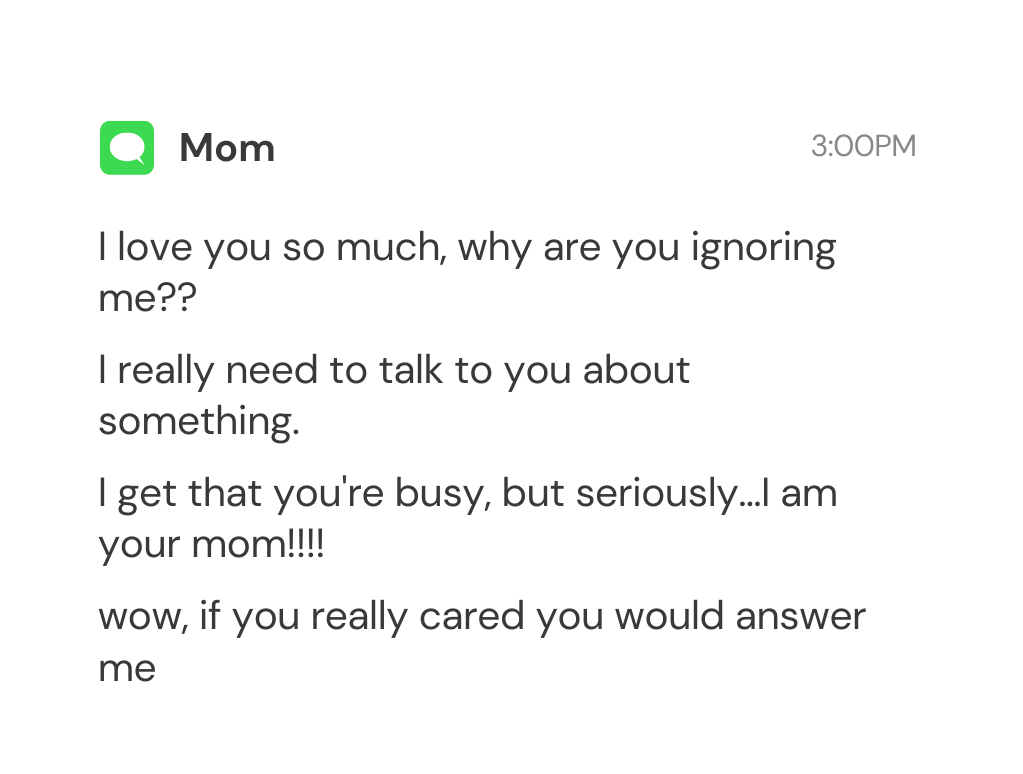Why Enmeshment Happens In Families And Who Can Help Prevent It
It’s hard for a family to feel safe and genuinely close when there are problematic patterns of enmeshment.

Andrea’s face appears on the screen in front of me. We exchange brief pleasantries before she pulls out her phone and begins scrolling. “I want to read you something,” she tells me without breaking eye contact from her phone.
Andrea starts reading me a text from her mother. Her mom sent a series of text messages during the workday. It started with venting about something. Twenty minutes passed, and Andrea still hadn’t responded. “I was in a meeting,” she tells me. Her mom starts firing off text messages about how she’s her mother, she needs to respond, she needs her, and if she doesn’t respond soon, she will be so upset.

Andrea holds her phone to the computer screen to show me how many texts her mom sent and then tosses it across the room. I hear it hit the floor, and I don’t blame her for that reaction.
These texts are just one example of how Andrea and her mother have become trapped in a cycle of enmeshment. Andrea is her mother’s emotional support person and she’s expected to provide this support anytime, anywhere. If she doesn’t provide immediate support, she gets punished. Andrea wants to be a good daughter. She wants to be loving and supportive and needs her life back. She can’t be at the mercy of her mother’s moods. The cycle of enmeshment has to end with her.
Why Enmeshment Happens In Families
Family enmeshment happens when there are no clear roles or boundaries. It can become particularly damaging when there is no divide between generations of the family (like parents and children). This is what I am working on with Andrea.
Now, I will give you a list of situations that can lead to enmeshment. They do not always lead to enmeshment. We know this is highly nuanced and depends on many factors in the family, like culture, resources, developmental stage, resources, etc. What feels like enmeshment for some families will feel healthy for others. As you read through this list, you can ask yourself: if this issue impacted your family, how did it feel during different parts of your life? How is it affecting you today?
- Addiction and Substance Abuse
Families with addiction often struggle with enmeshment, boundary setting, and role confusion. A parent with a SUD may be preoccupied with getting high, spend significant amounts of time recovering from the effects of substances, or have mood changes. This may cause them to miss opportunities to develop a healthy attachment with their child. Eye contact, tone, volume, touch, and the ability to assess the infant's needs are all essential building blocks of attachment. Without a healthy attachment system, a child is much more vulnerable to stress and may struggle with anxiety, depression, and other mental illness.
Children who grow up in homes with addiction become skilled at suppressing or ignoring their needs and assessing their parent's needs. When a parent cannot provide you with what you need, you find ways to silence that need. When a parent only shows you attention with you are helping them, you will find a way to always be needed. A parent trapped in the cycle of addiction may also have loose boundaries with their child, put them in situations that are not appropriate or safe for a child, and be unable to adequately meet their child’s developmental, emotional, and physical needs.
- Health Issues
Many parents and children will become ill throughout their lifetime. Single-incident health issues and chronic conditions can result in enmeshment when they are not handled developmentally appropriately for that child. Research shows that certain diagnoses (like Autism Spectrum Disorder) benefit from higher parental involvement. What may seem like enmeshment in a “healthy” family can feel appropriate in a family struggling with a specific diagnosis or issue.
Enmeshment usually happens when children are overly involved in the parent's care and have to take on tasks better suited for an adult or when a parent cannot let go of being overly involved in a child’s life despite their improvement. Some parents get stuck using the same approach and become overly involved in their children's day-to-day interactions.
- It’s What Has Always Been Done
Enmeshment is a generational pattern that is passed down. If you grew up in a family with loose boundaries, you’re much more likely to continue that pattern in your own family. People like you (reading this right now) are the ones who can say wow, this isn’t what I want for my family.
- Mental Illness
Similar to addiction, mental illness in the family can lead to enmeshment. In an attempt to be caring, certain members may become overly involved in managing the person who is struggling. Certain mental health diagnoses may also make maintaining boundaries in the family difficult.
It Doesn’t Have To Be Like This
Many families struggle with addiction, chronic illness, mental illness, or generational patterns. Not all of these families are doomed to enmeshment. It is possible to handle these issues as a family, maintain boundaries, and experience closeness.
You are reading this article for a reason. Maybe you’ve noticed how patterns of enmeshment have helped issues in your family spiral out of control. Maybe you want more privacy or better boundaries. It’s hard for a family to feel safe and genuinely close when there are problematic patterns of enmeshment.
If you want to end patterns of enmeshment in your family, I want you to know it is possible. Here is where to start:
- Explore the reasons why your family may be struggling with this. Is there a clear beginning to this pattern that you can identify? Do any of the reasons I listed apply to your family?
- Identify the ways enmeshment is negatively impacting your family. What problems are getting worse?
- Remind yourself that you are not doomed to repeat the patterns in your family. You’re reading this because you are aware of what is going on. Awareness is the first step.
- Identify what boundaries you need to set in your family. Don’t focus on what they need to change; focus on what you can do to keep yourself safe or how you can stop participating in certain dynamics.
- Identify who you are as a person. Spend time exploring who you are outside of your family. What are you interested in? What do you like doing?
- Seek out allies and support. Is there anyone else in the family that sees what you see? Do you have any friends that are also working to end patterns of dysfunction in their family?
You can decide how you want your family to function as an adult. That might mean changing your behavior, setting boundaries, or walking away. But I want you to remember this: I am an adult now, and I have power. I do not have to do what has always been done. I get to create the family that makes sense for me and my life. Those people might be blood-related to me, they might not be.